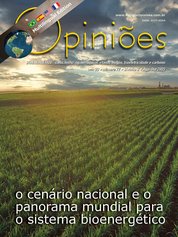Pedro Felipe de Castro Andrade
Industrial Director of Cerradão
OpAA77
The innovation of the bioenergetic sector in the digital age
Brazil is the largest producer of sugar cane in the world, with an average annual production of over 600 million tons, according to reliable sources, which places it in first place in the world production of sugar and in second place in the production of ethanol. The excellent agricultural and climatic conditions have always contributed to this extraordinary prominent position occupied by the country.
Sugarcane is crushed in more than 360 industrial units spread across the country, mostly in the Center-South and Northeast regions. The Brazilian industrial park has a production chain of excellence, highly specialized and fully nationalized, both with regard to industrial inputs and the supply and replacement of machines, equipment, services, systems and technologies in general. Without a doubt, Brazil is a world reference in sugarcane processing.
The great importance of the sugar-energy sector for the Brazilian economy is also indisputable, as it represents around 2% of the national Gross Domestic Product, with the generation of more than 700 thousand direct jobs, in addition to several other contributions, such as the generation of almost 5% of the country's electricity.
The sugar-energy industry must explore the widest possible range of products and services that are within its reach. From the most to the least noble, it is inevitable to take advantage of all existing opportunities. And they are not few.
Electric power cogeneration is an example of taking advantage of a very interesting opportunity. In the case of renewable electrical energy from biomass (sugarcane bagasse), without any aggression to the environment, available in periods of drought when the reservoirs are no longer irrigated by rain.
Even with regard to cogeneration of electric energy, we cannot forget the possibility of increasing its production using the biogas that can be extracted from vinasse. Recent studies show that the product itself is commercially viable, using it to replace diesel in trucks and other vehicles at the service of the industrial unit.
We also have corn ethanol and second generation ethanol. The corn used in production is fully utilized, separating the starch, used in the production of ethanol, from the fiber, fat and protein, used in the manufacture of animal nutrition products, thus generating a new product for the industrial unit.
Second-generation ethanol, on the other hand, derived from the use of sugarcane residues and its processing, such as straw, bagasse, etc., also appears to be another valuable product opportunity. Despite being chemically the same, second-generation ethanol has pricing quite different from ethanol, given its sustainability.
More than a capacity to produce several products, the most important thing is the existence of a capacity to make the ethanol and sugar production mix more flexible. Both hydrated and anhydrous ethanol compete with fossil fuels, whose prices are subject to numerous injunctions of the most varied nature, national and international. This reflects directly on the price of ethanol, regardless of its production costs.
With sugar it is not very different, in addition to suffering from fluctuations in ethanol, it also suffers from issues related to supply and international stocks. For no other reason, the flexibility of the mix of production is a feature of paramount importance for any industrial unit.
Cerradão produces white sugar and sugar with very high polarization. It also produces anhydrous ethanol and hydrated ethanol. The flexibility in our mix of production, allows us to direct up to 60% of the sugarcane to manufacture sugar or up to 70% to manufacture ethanol. In the current harvest of 2023, 2024, we have a crushing forecast of 5.5 million tons of sugarcane.
Electric power cogeneration is another of Cerradão's prides. And the amount of electricity generated has been maintained over time, in terms of megawatts per ton of crushed sugarcane, following the substantial increase in crushing in recent years.
Another important factor that contributes to a good performance in the sugar-energy sector is the digitized management of the industrial process reconciled with modern technological solutions.
The world is undergoing significant changes, in addition to experiencing numerous demands and requirements that were previously unthinkable. When it comes to goods, such as sugar and ethanol, the sugarcane industry must seek new parameters and new conditions for the survival and perpetuation of the business.
The connection of the entire production process, with the generation of data and production information in real time, allows efficient production control. Coupled with the mapping of the production process, digitization provides quick and effective responses for the best use of production, with the possibility of improving the industrial process at each new cycle.
In summary, this is what we have sought to achieve at Cerradão, as Industrial Director and together with the other Directors, Directors and Shareholders. For no other reason, we believe and have reaped good results in our management.
Biogas, and many other existing or future alternatives, will always be on the radar. Our business requires a lot of investment in equipment and technology, but we believe that people make the difference. For no other reason, we invest a lot in the training and development of our employees, in the planning and systematization of our processes, in addition to numerous environmental, social and corporate governance policies.




